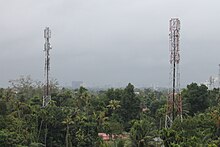മൊബൈൽ ഫോൺ വികിരണം

മൊബൈൽ ഫോൺ പ്രവർത്തിക്കുമ്പോൾ പുറപ്പെടുവിക്കുന്ന വികിരണം (Radiation) മനുഷ്യന്റെ ആരോഗ്യത്തെ എങ്ങനെ ബാധിക്കുന്നു എന്നുള്ള പഠനത്തിനു വളരെ ഏറെ പ്രസക്തി ഉണ്ടായിരിക്കുകയാണ്. ജൂൺ 2009-ലെ കണക്കനുസരിച്ച് 430 കോടി ജനങ്ങൾ ലോകമെമ്പാടുമായി മൊബൈൽ ഫോൺ ഉപയോഗിക്കുന്നു.[1]). ഏറ്റവും കുറഞ്ഞ തരംഗദൈർഘ്യം ഉള്ള വൈദ്യുതകാന്ത തരംഗങ്ങൾ (Microwave ) ഉപയോഗിച്ചാണ് ആണ് മൊബൈൽ ഫോൺ പ്രവർത്തിക്കുന്നത്. വാർത്ത വിനിമയ രംഗത്തെ മിക്ക ഉപകരണങ്ങളും ഇതേ തരത്തിലുള്ള വികിരണം വിവിധ അളവുകളിൽ പുറത്തുവിടുന്നുണ്ട്.
ലോകാരോഗ്യസംഘടനയുടെ വെളിപ്പെടുത്തലുകൾ
അന്തർരാഷ്ട്ര അർബുദ ഗവേഷണ കേന്ദ്രത്തിന്റെ (IARC) അർബുദജന്യ ഗണപട്ടികയിൽ വൈദ്യുതകാന്ത റേഡിയോ തരംഗങ്ങൾക്ക് 2B ആയി സ്ഥാനം നൽകിയതിനെ തുടർന്ന്, 31 മെയ് 2011-ൽ ലോകാരോഗ്യസംഘടന, മൊബൈൽ ഫോൺ വികിരണം മനുഷ്യരിൽ അർബുദം ഉണ്ടാക്കിയേക്കാമെന്നു വെളിപ്പെടുത്തി. 14 രാജ്യങ്ങളിൽ നിന്നായി 31 വിദഗ്ദ്ധർ ഉൾപ്പെട്ട യോഗം ഫ്രാൻസിലെ ലിഓൻ പട്ടണത്തിൽ എട്ടു ദിവസ്സത്തെ ചർച്ച നടത്തിയിരുന്നു. കഴിഞ്ഞ ഒരു ദശകത്തിൽ നടത്തിയ ഏറ്റവും ദീർഘമായ രണ്ടു ഗവേഷണങ്ങളിൽ, ഏറ്റവും കൂടുതൽ സമയം മൊബൈൽ ഫോൺ ഉപയോഗിക്കുന്നവരിലാണ് കൂടുതൽ സാധ്യതയെന്ന് കണ്ടെത്തി. 13000 പേരാണ് പരീക്ഷണത്തിൽ പങ്കെടുത്തത്. മൊബൈൽ ഫോൺ കൂടുതൽ ഉപയോഗിക്കുന്നവർക്ക് ഗ്ലയോമ (Glioma ) എന്ന തലച്ചോറിനെ ബാധിക്കുന്ന അർബുദം വരാനുള്ള സാധ്യത 40% കൂടുതലാണ്, അതായത് ദിവസം 30 മിനിട്ട് വീതം 10 വർഷം ഉപയോഗിച്ചവർക്ക് [2] [3] മൊബൈൽ ഫോൺ വികിരണം മറ്റ് അർബുദങ്ങൾക്കും കാരണമാകുമോ എന്നതിനെക്കുറിച്ച് തീർച്ചപ്പെടുത്തുവാൻ ഇതുവരെ ഉള്ള പഠനങ്ങൾക്ക് കഴിഞ്ഞിട്ടില്ല. അർബുദജന്യമാണെന്ന 2-ബി തരംതിരിവ് യുക്തിസഹജമെന്നാണ് ലോകാരോഗ്യസംഘടന അവരുടെ റിപ്പോർട്ടിൽ ഉറപ്പിച്ചു പറയുന്നത്. പഠന റിപ്പോർട്ടുകൾ മാറ്റി തെളിയിക്കുന്നതുവരെ മൊബൈൽ ഫോൺ വികിരണം കുറക്കുന്നതിലേക്കായി സ്പീക്കർ അല്ലെങ്കിൽ ഹെഡ് സെറ്റുകൾ ഉപയോഗിക്കുക, സംസാരം ഒഴിവാക്കി ടെക്സ്റ്റ് മെസ്സേജ് ആശ്രയിക്കുക, അതുവഴി തലച്ചോറുമായുള്ള പ്രോസസർ സാമീപ്യം പരമാവധി അകറ്റുക, എന്നതാണ് പ്രായോഗിക നിർദ്ദേശം [2][4] ഇതൊന്നുമല്ലെങ്കിൽ ലാൻഡ് ഫോൺ ഉപയോഗിക്കുകയാണ് നല്ലതെന്ന് ലോകാരോഗ്യസംഘടന.
മൊബൈൽ ടവറുകൾ മൂലം ആരോഗ്യപ്രശ്നങ്ങളുണ്ടാകാനുള്ള സാദ്ധ്യത

ഉത്കണ്ഠയുണ്ടാക്കുന്ന മറ്റൊരു വിഷയം മൊബൈൽ ടവറുകൾ പോലെ സ്ഥാവരമായ സംഗതികളിൽ നിന്നുണ്ടാകുന്ന വികിരണങ്ങളാണ്. മൊബൈൽ ഫോണിനെ അപേക്ഷിച്ചുനോക്കുമ്പോൾ ടവറുകളിൽ നിന്നുണ്ടാകുന്ന വികിരണങ്ങൾ തുടർച്ചയായി പ്രസരിച്ചുകൊണ്ടിരിക്കുന്നതും അടുത്തുള്ള സ്ഥലത്ത് ഇത് കൂടുതൽ ശക്തമായതുമാണ്. എന്നാലും വികിരണങ്ങളുടെ ശക്തി ദൂരേയ്ക്ക് പോകുന്തോറും വളരെപ്പെട്ടെന്ന് കുറഞ്ഞുവരും.
100 വാട്ടിൽ കുറഞ്ഞ ശക്തിയുപയോഗിച്ചാണ് ബേസ് സ്റ്റേഷനുകൾ പ്രവർത്തിക്കുന്നത്. ഇതുകൊണ്ട് തറനിരപ്പിലുള്ള വികിരണശക്തി മൊബൈൽ ഫോണിനേക്കാൾ കുറവായിരിക്കുമത്രെ. ബേസ് സ്റ്റേഷനുകൾക്കടുത്ത് താമസിക്കുന്നവർക്ക് പലതരം രോഗലക്ഷണങ്ങളുണ്ടാകുന്നതായുള്ള റിപ്പോർട്ടുകൾ പല സർവേകളും കാണിക്കുന്നു. [5][6][7][8][9] എന്നാലും ടവറുകൾക്കടുത്ത് താമസിക്കുന്നവരെപ്പറ്റി ശാസ്ത്രീയ പഠനം നടത്തുന്നതും ഓരോ വ്യക്തികളും എന്തുമാത്രം വികിരണമേറ്റിട്ടുണ്ട് എന്നളക്കുന്നതും വളരെ ബുദ്ധിമുട്ടുള്ള കാര്യമാണ്. [10] Self-report studies can also be vulnerable to the nocebo effect.
എസ്സക്സ് സർവ്വകലാശാലയിൽ നടത്തിയ രണ്ട് ഡബിൾ ബ്ലൈൻഡ് പരീക്ഷണങ്ങളിലും സ്വിറ്റ്സർലാന്റിൽ നടത്തിയ ഒരു പരീക്ഷണത്തിലും [11] ഇത്തരം രോഗലക്ഷണങ്ങളെപ്പറ്റി പരാതിപ്പെട്ടവരിൽ ലക്ഷണങ്ങൾക്ക് കാരണമായത് മൊബൈൽ ടവറുകളായിരിക്കാൻ സാദ്ധ്യതയില്ല എന്നാണ് കണ്ടെത്തപ്പെട്ടത്. [12] എസ്സക്സ് പഠനത്തിൽ പങ്കെടുത്തവർക്ക് ഇലക്ട്രോമാഗ്നറ്റിക് വികിരണങ്ങൾ ഏൽക്കുന്നുണ്ടോ ഇല്ലയോ എന്ന് ഊഹിക്കാൻ സാധിച്ചില്ല. സൗഖ്യക്കുറവ് ഉണ്ടെന്ന് പരാതിപ്പെട്ടവർ വികിരണങ്ങളേൽക്കുന്നവരും ഇല്ലാത്തവരുമുണ്ടായിരുന്നു. പരീക്ഷണം നടത്തിയയാൾ എത്തിയ നിഗമനം - "ചില വ്യക്തികൾക്ക് ശരിയായ രോഗലക്ഷണങ്ങളുണ്ട് എന്നത് വ്യക്തമാണ്. ഇത്തരം ആൾക്കാരുടെ ജീവിതം ഗുണം കുറഞ്ഞതുമാണ്. മറ്റെന്തു കാരണങ്ങളാണ് ഈ ലക്ഷണങ്ങളുണ്ടാക്കുന്നത് എന്ന് കണ്ടെത്തേണ്ടതുണ്ട്. അതിനായി വേണ്ട പഠനങ്ങളും ചികിത്സാരീതികളും വികസിപ്പിക്കേണ്ടതുണ്ട്."
ഫ്രാൻസിലെ വിദഗ്ദ്ധരുടെ അഭിപ്രായത്തിൽ ടവറിലെ ആന്റിനയുടെ വികിരണത്തിന്റെ പാത മനുഷ്യവാസമുള്ള പ്രദേശത്തിന്റെ നൂറുമീറ്ററിൽ കുറവ് അകലത്തിലാവരുത് എന്നാണ്. [13] 2003-ൽ ഈ ശുപാർശ പരിഷ്കരിക്കപ്പെട്ടു. [14] സ്കൂളുകൾക്കും കുട്ടികളുമായി ബന്ധപ്പെട്ട സ്ഥാപനങ്ങൾക്കും 100 മീറ്ററിനുള്ളിലുള്ള ആന്റിനകൾ കൂടുതൽ മെച്ചപ്പെട്ട രീതിയിൽ വിന്യസിപ്പിക്കണമെന്ന ഈ പരിഷ്കാരം 2005-ലെ വിദഗ്ദ്ധ റിപ്പോർട്ടിൽ ഉൾപ്പെടുത്തപ്പെട്ടില്ല. [15] ഇപ്പോൾ ഫ്രാൻസിലെ പരിസ്ഥിതി സംബന്ധിച്ച ഏജൻസി പറയുന്നത് കുറച്ചുകാലം മാത്രം ഇത്തരം വികിരണങ്ങളേറ്റാൽ ആരോഗ്യപ്രശ്നങ്ങളുണ്ടാവുമെന്ന് തെളിയിക്കപ്പെട്ടിട്ടില്ല എന്നാണ്. ദീർഘകാലപ്രശ്നങ്ങളെപ്പറ്റിയുള്ള ചോദ്യങ്ങൾക്ക് ഉത്തരങ്ങൾ ലഭ്യമല്ല. [16]
അവലംബം
- ↑ "Market Data Summary (Q2 2009)". GSM Association. Retrieved 2010-01-30.
- ↑ 2.0 2.1 "World Health Organization/International Agency for Research on Cancer Classifies Radiofrequency Electromagnetic Fields as Possibly Carcinogenic to Humans" (PDF). World Health Organization. Retrieved 2011-05-31.
- ↑ "World Health Organization: Cell Phones May Cause Cancer". Business Insider. Retrieved 2011-05-31.
- ↑ Hachman, Mark (31 May 2011). "WHO Finds Tentative Link Between Cell Phones, Cancer". pcmag.com. Retrieved 2011-06-01.
- ↑ Santini, R (2003). "Survey Study of People Living in the Vicinity of Cellular Phone Base Stations". Electromagnetic Biology and Medicine. 22 (1). London: Informa Healthcare: 41–49. doi:10.1081/JBC-120020353. OCLC 88891277. Retrieved 2008-02-09.
{cite journal}: Cite has empty unknown parameters:|laysummary=and|quotes=(help); Unknown parameter|coauthors=ignored (|author=suggested) (help); Unknown parameter|month=ignored (help) - ↑ Navarro, Enrique A (2003). "The Microwave Syndrome: A Preliminary Study in Spain". Electromagnetic Biology and Medicine. 22 (2). London: Informa Healthcare: 161–169. doi:10.1081/JBC-120024625. OCLC 89106315. Retrieved 2008-02-09.
{cite journal}: Cite has empty unknown parameters:|laysummary=and|quotes=(help); Unknown parameter|coauthors=ignored (|author=suggested) (help); Unknown parameter|month=ignored (help)
Oberfeld, Gerd (2004). "The Microwave Syndrome: Further Aspects of a Spanish Study". In Kostarakis, P (ed.). Biological effects of EMFs : Proceedings, Kos, Greece, 4–8 October 2004, 3rd International Workshop. Ioannina, Greece: Electronics, Telecom & Applications Laboratory, Physics Dept., University of Ioannina : Institute of Informatics & Telecommunications, N.C.S.R. “Demokritos”. ISBN 960-233-152-6.{cite book}:|access-date=requires|url=(help);|archive-url=requires|url=(help); External link in|chapterurl=|chapterurl=ignored (|chapter-url=suggested) (help); Unknown parameter|coauthors=ignored (|author=suggested) (help) - ↑ Abdel-Rassoul, G (2007). "Neurobehavioral effects among inhabitants around mobile phone base stations" (PDF). NeuroToxicology. 28 (2). New York, NY: Elsevier Science: 434–40. doi:10.1016/j.neuro.2006.07.012. OCLC 138574974. PMID 16962663. Archived from the original (PDF) on 2008-04-14. Retrieved 2008-02-10.
{cite journal}: Cite has empty unknown parameters:|laysummary=,|laydate=,|laysource=, and|quotes=(help); Unknown parameter|coauthors=ignored (|author=suggested) (help); Unknown parameter|month=ignored (help) - ↑ Bortkiewicz, A (2004). "Subjective symptoms reported by people living in the vicinity of cellular phone base stations: review". Medycyna pracy (in Polish). 55 (4). Warsaw: Państwowy Zakład Wydawnictw Lekarskich: 345–352. ISSN 0465-5893. OCLC 108011911. PMID 15620045. BL Shelfmark: 5536.020000.
{cite journal}: Cite has empty unknown parameters:|laysummary=,|laydate=,|laysource=,|month=, and|quotes=(help); Unknown parameter|coauthors=ignored (|author=suggested) (help)CS1 maint: unrecognized language (link) - ↑ Hutter, H-P (May 1, 2006). "Subjective symptoms, sleeping problems, and cognitive performance in subjects living near mobile phone base stations". Occupational and Environmental Medicine. 63 (5). London, UK: the BMJ Publishing Group: 307–313. doi:10.1136/oem.2005.020784. OCLC 41236398. PMC 2092490. PMID 16621850. Retrieved 2008-01-07.
{cite journal}: Cite has empty unknown parameters:|laydate=,|laysource=,|quotes=, and|laysummary=(help); Unknown parameter|coauthors=ignored (|author=suggested) (help) - ↑ Feasibility of future epidemiological studies on possible health effects of mobile phone base stations, Neubauer et al., Bioelectromagnetics, 28(3):224-230, March 2007 at http://www3.interscience.wiley.com/cgi-bin/abstract/113448948/ABSTRACT[പ്രവർത്തിക്കാത്ത കണ്ണി]
- ↑ UMTS Base Station-Like Exposure, Well Being and Cognitive Performance Regel et al., Environmental Health Perspectives, 114(8):August 2006 at http://www.ehponline.org/docs/2006/8934/abstract.html Archived 2009-02-01 at the Wayback Machine
- ↑ Eltiti, S (2007). "Does short-term exposure to mobile phone base station signals increase symptoms in individuals who report sensitivity to electromagnetic fields? A double-blind randomized provocation study". Environ Health Perspect. 115 (11): 1603–1608. doi:10.1289/ehp.10286. OCLC 183843559. PMC 2072835. PMID 18007992.
{cite journal}: Cite has empty unknown parameter:|quotes=(help); Unknown parameter|coauthors=ignored (|author=suggested) (help); Unknown parameter|laydate=ignored (help); Unknown parameter|laysource=ignored (help); Unknown parameter|laysummary=ignored (help); Unknown parameter|month=ignored (help) - ↑ http://www.afsset.fr/index.php?pageid=712&parentid=424 Archived 2013-03-20 at the Wayback Machine page 37
- ↑ Téléphonie mobile et santé, Rapport à l'Agence Française de Sécurité Sanitaire Environnementale, 21 March 2003 at http://www.afsset.fr/index.php?pageid=712&parentid=424 Archived 2013-03-20 at the Wayback Machine
- ↑ Téléphonie mobile et santé, Rapport du groupe d’experts, l'Agence Française de Sécurité Sanitaire Environnementale, April 2005 at http://www.afsset.fr/index.php?pageid=712&parentid=424 Archived 2013-03-20 at the Wayback Machine
- ↑ "Radiofréquences : actualisation de l'expertise (2009)", l'Agence Française de Sécurité Sanitaire Environnementale, April 2005 at http://www.afsset.fr/index.php?pageid=712&parentid=424 Archived 2013-03-20 at the Wayback Machine